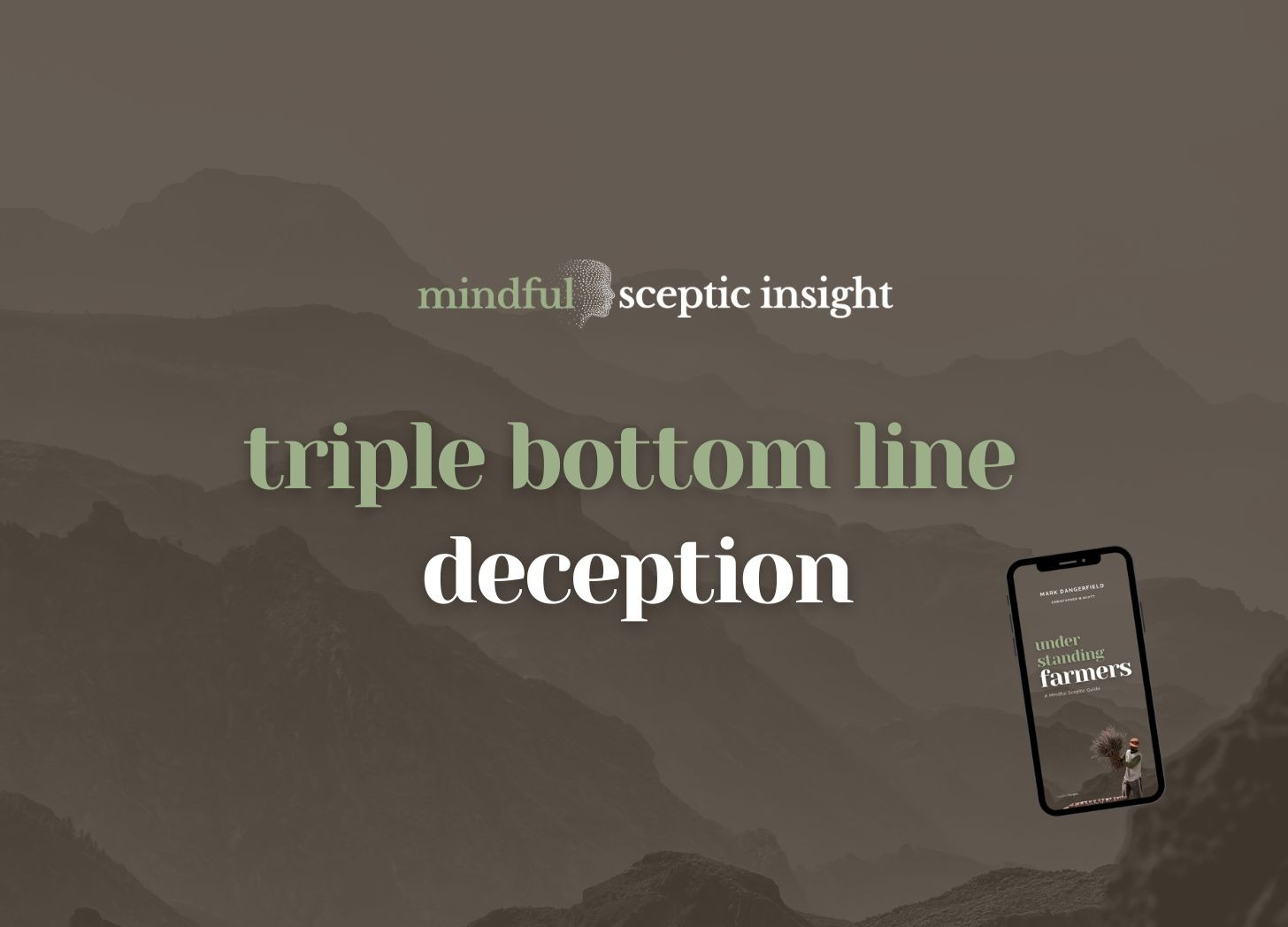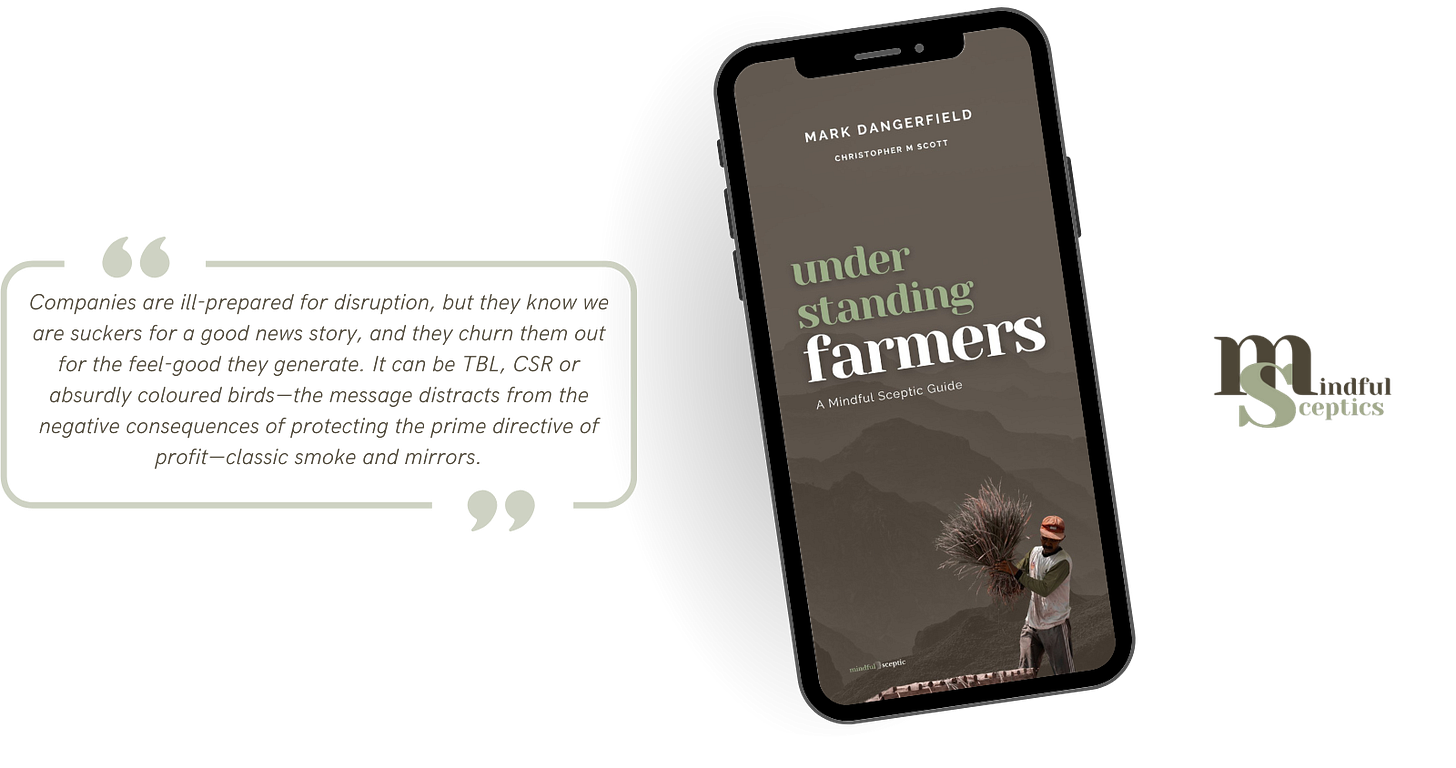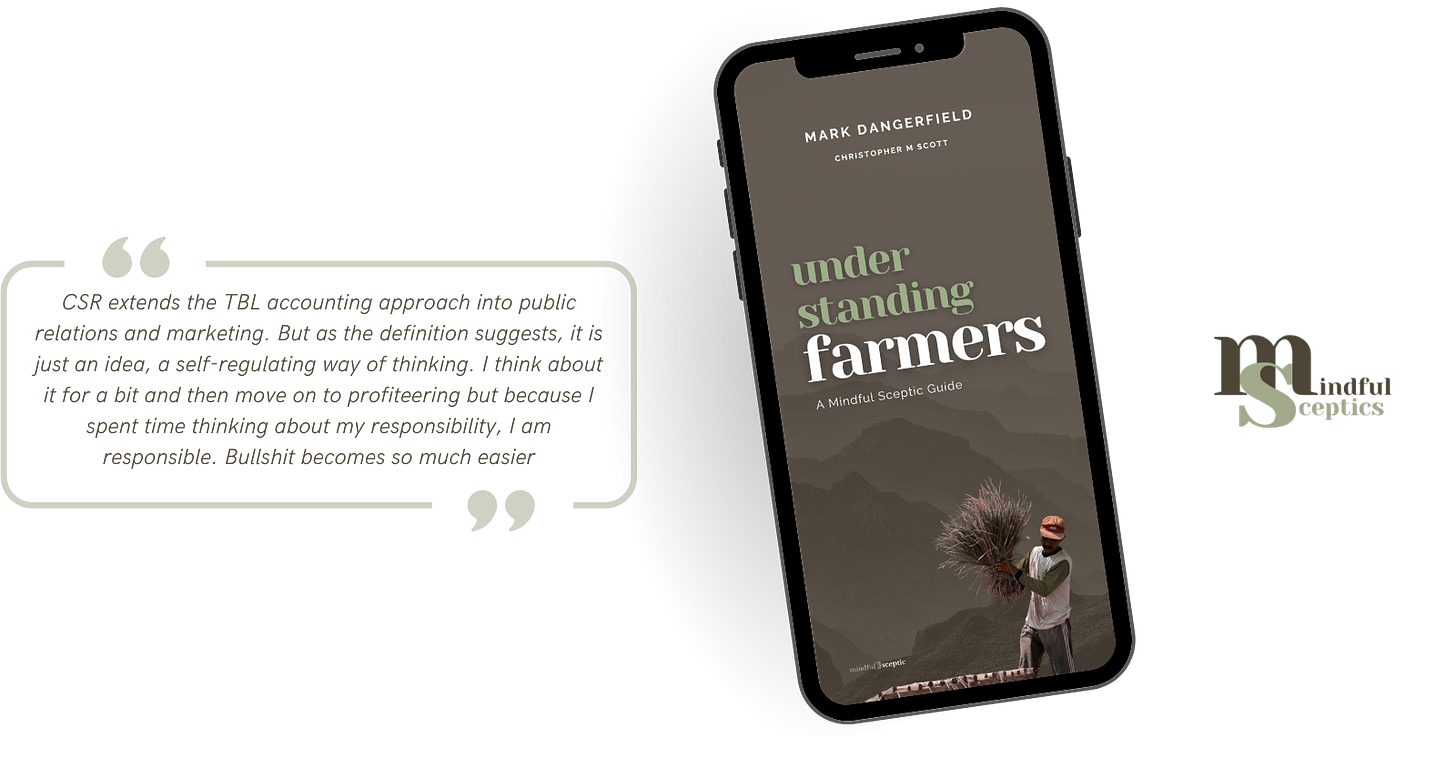Core Idea
Walk into any boardroom these days, and you’ll hear the same chat. Men mostly, in suits and silk ties, will be telling each other ‘We’re committed to the triple bottom line’ of people, planet, profit. It will sound balanced, progressive, even enlightened.
The idea that businesses can deliver economic returns while simultaneously improving social outcomes and environmental health feels like a step in corporate evolution. They finally get it.
John Elkington coined the TBL concept decades ago as a genuine challenge to business-as-usual thinking. The premise was to expand accountability beyond the financial bottom line to include social and environmental impacts.
Measuring what matters should make it possible to hold companies accountable for their full footprint, not just their profit margin.
On the surface, it’s compelling.
A farm that generates steady income while supporting rural communities and protecting biodiversity through minimal tillage and native vegetation corridors. Everyone wins—farmer, community, ecosystem. The romantic notion of win-win-win scenarios has captured imaginations across corporate suites, sustainability conferences, and ESG investment strategies.
The language is everywhere.
Annual reports brim with triple bottom line commitments. Companies showcase their social responsibility initiatives alongside glossy photos of renewable energy installations and smiling employees volunteering at local charities.
Investors pour billions into ESG funds, convinced they’re backing genuine systemic change.
Counterpoint
Well, here’s the thing.
The bottom line remains ruthlessly singular.
Twenty-five years of triple bottom line rhetoric, and what do we have to show for it? Accelerating ecological collapse, widening inequality, and corporate profits at historic highs. The concept’s own inventor, John Elkington, issued a “product recall” in 2018, admitting that TBL had morphed into an accounting exercise rather than driving fundamental change.
The uncomfortable truth is that TBL functions as corporate theatre.
It provides the language of responsibility without requiring substantive sacrifice. Companies can trumpet their environmental initiatives while continuing to extract resources at unsustainable rates. They can celebrate social programs while maintaining exploitative labour practices in distant supply chains.
The mathematical reality is stark.
Robert Reich, former US Secretary of Labour, cuts through the pleasant fiction when he says, “CEOs won’t do anything that hurts their bottom lines. They’re in the business of making as much money as possible, not solving social problems.” Their soothing promises of social responsibility serve primarily to forestall regulation and maintain social licence to operate.
The TBL framework enables companies to cherry-pick metrics that enhance their performance, while overlooking systemic impacts. A mining company can highlight its community development programs while the environmental cost of extraction remains externalised. A fast-fashion retailer can showcase recycling initiatives while business models predicated on disposability drive ever-increasing consumption.
Even farmers who are often held up as TBL exemplars reveal the framework’s limitations.
When researchers asked them directly, farmers prioritised economic returns because their livelihoods depend on them. Environmental and social considerations remain secondary concerns, constrained by the immediate pressures of cash flow and debt service.
Across all sectors, the evidence consistently shows economic factors take precedence over other considerations when trade-offs become necessary.
And this is all perfectly understandable, even predictable.
Just the temporal mismatch alone makes genuine integration nearly impossible. Economic outcomes operate on quarterly cycles while ecological and social benefits unfold over decades. Corporate governance structures, shareholder expectations, and executive compensation all reward short-term performance, making the patient capital required for systemic change structurally difficult.
And should the boardroom suits fail to prioritise profit, they risk more than dismissal from their plush positions.
Thought Challenge
Dissect the theatre… Take any major company’s sustainability report. Count how many pages focus on intentions versus measurable outcomes. Look for specific commitments with deadlines and accountability mechanisms. Ask yourself what would happen to the share price if they actually delivered on every promise?
Follow the money... Trace one product you use regularly from raw materials to disposal. At each stage, identify who captures the value and who bears the costs. Notice how TBL accounting typically stops at the company’s direct operations, excluding the externalised impacts that make their business model viable.
Closing Reflection
The insidious genius of triple bottom line thinking is that it’s right enough to be credible while being weak enough to be harmless. It allows institutions to speak the language of transformation while preserving the systems that created our crises.
Being a mindful sceptic means recognising that good intentions, however eloquently expressed, don’t suspend economic gravity.
The bottom line remains singular, not because business leaders lack compassion, but because that’s how the system works. Until we change the rules that reward extraction over regeneration, TBL will remain what it has always been…
Beautiful rhetoric covering up an ugly truth.
Evidence Support
Milne, M. J., & Gray, R. (2013). W(h)ither ecology? The triple bottom line, the Global Reporting Initiative, and corporate sustainability reporting. Journal of Business Ethics, 118(1), 13–29.
TL;DR… sustainability and the triple bottom line (TBL) are portrayed in corporate sustainability reporting, showing that TBL has largely been reduced to an accounting exercise rather than a meaningful ecological or social reform. The authors argue that reporting frameworks like the Global Reporting Initiative help corporations maintain legitimacy while deflecting genuine accountability.
Relevance to insight… supports the assertion that the TBL is more an exercise in public relations and “smoke and mirrors” than a true tool for transformation, highlighting how the rhetoric of sustainability is decoupled from substantive change.
Boiral, O. (2013). Sustainability reports as simulacra? A counter-account of A and A+ GRI reports. Accounting, Auditing & Accountability Journal, 26(7), 1036–1071.
TL;DR… analyses “best-in-class” sustainability reports and concludes that even top-performing companies provide accounts that are largely symbolic and decoupled from their operational reality. The paper documents how reporting practices can create a “simulacrum”—an appearance of responsibility and transparency that satisfies stakeholders but fails to reflect genuine change.
Relevance to insight… the review of “A+” sustainability reports provides empirical evidence that triple bottom line reporting may focus more on impression management than on concrete environmental or social progress, validating the “smoke and mirrors” argument.
Hahn, T., Figge, F., Pinkse, J., & Preuss, L. (2010). Trade‐offs in corporate sustainability: You can’t have your cake and eat it. Business Strategy and the Environment, 19(4), 217–229.
TL;DR… the TBL framework systematically underplays the reality of trade-offs and conflict between economic, social, and environmental goals, leading to misleading expectations of “win-win-win” outcomes. Through theoretical and empirical analysis, they demonstrate that hard choices and negative externalities are routinely disguised or ignored in mainstream sustainability management.
Relevance to insight… critiques the TBL’s simplification of sustainability and reveals how its structure can be misused as a comfort story for business-as-usual, highlighting the deficiencies underlined by the insight.
Palazzo, G., & Richter, U. (2005). CSR business as usual? The case of the tobacco industry. Journal of Business Ethics, 61(4), 387–401.
TL;DR… analysing the tobacco industry’s use of CSR and triple bottom line language, Palazzo and Richter demonstrate that TBL initiatives can serve as a shield for fundamentally harmful business models, thereby enabling “business as usual” under the guise of ethical improvement. The case shows how TBL and CSR can be mobilised strategically to delay regulation and deflect criticism rather than drive real change.
Relevance to insight… potent example of how the TBL can be hijacked by corporate interests, perfectly illustrating the “smoke and mirrors” critique central to the insight.
These papers offer rigorous theoretical and empirical evidence that the triple bottom line is often more rhetoric and accounting theatre than a genuine solution to the conflicts at the heart of sustainability and responsible business.






